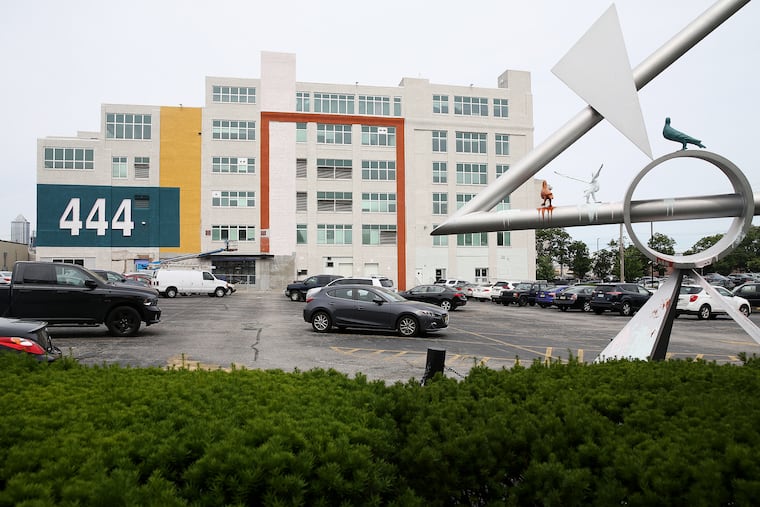Outdoor brand United By Blue chooses evolving industrial zone north of Center City for new offices
Nearly four years after Arts & Crafts began accumulating dilapidated and underutilized properties in a once-industrial area, its efforts are being validated.

United By Blue, the homegrown outdoor-outfitter, is moving its corporate offices into a former tannery building north of Center City, validating its soon-to-be landlord’s efforts to revamp the once-industrial area into a new business district by laying a groundwork of hip bars and restaurants.
The company plans to move late this year from its current home in Old City into an 8,000-square-foot space at 444 N. Third St., north of Callowhill Street, to accommodate a growing staff and consolidate its operations, cofounder Mike Cangi said.
Key to his decision, he said, was an opportunity to mix with the creative tenants who already have moved into what’s being branded as the Spring Arts District and to enjoy the eclectic street-level activity that the developer Arts & Crafts Holdings is working to introduce to the area.
“It’s a very holistic view of a neighborhood," Cangi said. "I’m excited to be part of that.”
Nearly four years after beginning to accumulate dilapidated and underutilized real estate in an area bound by Broad and Second Streets between Spring Garden and Callowhill, Arts & Crafts now has a portfolio of 23 commercial properties and two apartment buildings, over nearly 2 million square feet.
Joining United By Blue as a new commercial tenant in those buildings is Fishtown Analytics LLC, a tech company founded by alumni of the since-acquired data firm RJMetrics Inc., which is moving into about 5,000 feet of space at 915 Spring Garden St., a former Reading Railroad building.
New life also will be injected soon into the historic Northern Savings Fund & Safe Deposit Co. building at 600 Spring Garden St. — once home to the nightclub The Bank — when South Philadelphia-born specialty-foods stalwart Di Bruno Bros. begins operating a 4,000-square-foot banquet hall and catering operation on its ground floor.
Existing tenants across from Arts & Crafts’ buildings, meanwhile, include the mapping-software developer Azavea Inc., the Made Institute fashion-design school, and Beautylish Inc., an online cosmetics retailer that leases space in the same building as the former Electric Factory concert venue, now known as Franklin Music Hall.
At street level, drinking and dining establishments installed by Art & Crafts include Love City Brewing Co.'s pub and the Roy Pitz Brewing Co. bar and restaurant. Aiming to open before the end of the summer are the Triple Bottom Brewing Co. brewery and The Lucky Well, a barbecue joint.
Additionally, restaurateur Michael Pasquarello announced last year that he’s opening a Mexican-Chinese restaurant in what once was a quick-service garage at 11th and Spring Garden Streets, part of the Arts & Crafts-owned Union Transfer concert-hall property.
Pasquarello has since struck a deal for another eatery — cuisine to be decided — at 448 N. 10th St., a former bicycle factory building, said Craig Grossman, an Arts & Crafts partner.
On the nonedible front, Russo Music, an instrument seller based in Asbury Park, N.J., plans to open a 4,000-square-foot shop in a 10th and Spring Garden Street building that’s also part of the Union Transfer complex.
“With all these businesses and people we’re bringing in here to work during the days, those are potential customers for the retail and the food and beverage,” Grossman said. “They all feed off of each other.”
Not everyone is thrilled with Arts & Crafts’ big presence in the neighborhood, though.
Some in the community are suspicious of the group’s involvement in efforts to form a so-called Business Improvement District in the area, which would impose a levy on property owners within its boundaries to pay for neighborhood improvements.
Others are unhappy with Arts & Crafts’ renovations at the former Reading Railroad building at 915 Spring Garden St., which had accommodated about 100 artist studios before it was bought by the group. The number of studios has since been reduced to allow for bigger commercial tenants as well.
Adele Kubel, a painter, said she’ll soon be paying $500 a month for a studio that had cost $375 under the previous owner, who sold the property after city officials cited the building for safety violations following an electrical fire.
“They took a building that was, for over 30 years, available to average-income-level artists, and they turned it into a rich person’s place,” Kubel said.
Grossman said studio rents had to rise to pay for necessary features, such as sprinkler and heating systems.
For his part, United By Blue’s Cangi said he liked what he saw of the neighborhood when he was vetting locations for his company’s new headquarters.
His staff has grown from six to almost 40 since the company was founded in offices above its former flagship store at 144 N. Second St., and it’s poised to expand further as its online orders surge alongside sales through retailers such as L.L. Bean, REI, and Nordstrom.
At its future space, the company plans to consolidate its corporate offices with the photo studio it now houses in Kensington. Other space in the building, which is just a few blocks from United By Blue’s flagship store at Second and Race Streets, will be used to store trade-show supplies kept at yet another facility.
While there’s still less street life at 444 N. Third St. than in other parts of Arts & Crafts’ dominion, the landlord has decorated the building’s lobby in homage to its hide-tanning past with portrait paintings of humanoid animals in formal Victorian garb and a leather-netted pingpong table.
Cangi called the building’s decor “unique and quirky” and said being in the up-and-coming area would help his company keep cultivating its identity as an outdoor brand aimed at the young and ecologically minded.
“The neighborhood is going to provide us with additional opportunities for growth,” he said.